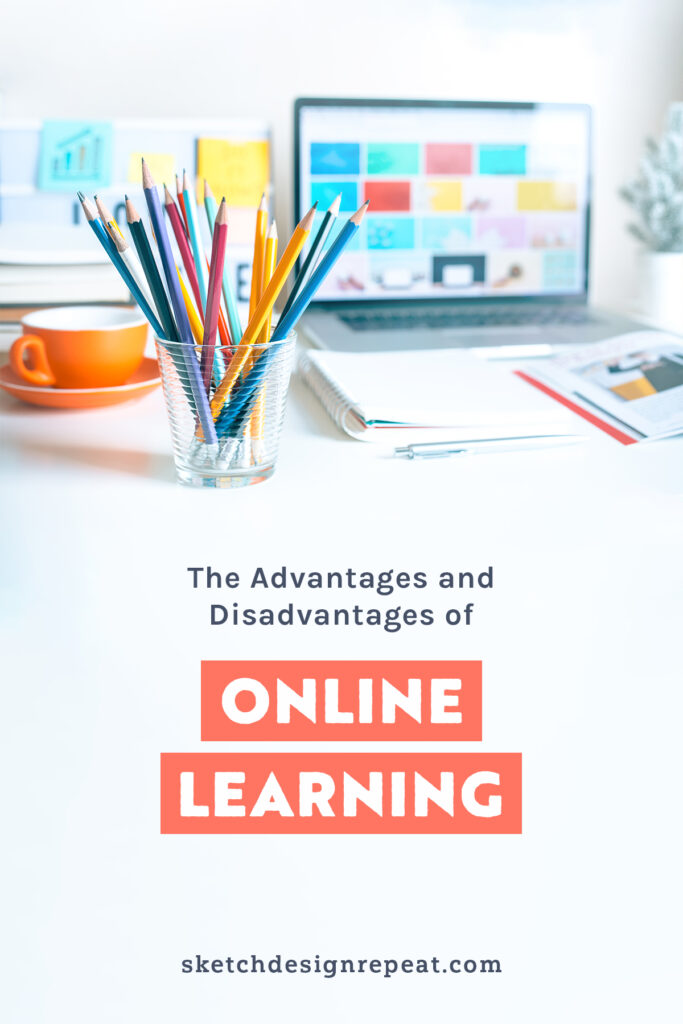Online education for surface design isn’t entirely new: it started some years ago thanks to the technology that made it possible and our overall transition from offline to the online world. But since the global pandemic, I feel like it has exploded and now we cannot think of a world without online education.

But before diving into the advantages and disadvantages, let’s go through all the different kinds of online learning available in the field of surface pattern design:
- Free courses and classes: Many educators offer a free introductory class to a bigger course they’re selling. It’s a great way to get to know the teacher and the way they teach.
- Tutorials on YouTube: Nowadays you can find tutorials for almost everything on YouTube, from how to make a repeat to things to consider when you decide to work with an agent.
- Online education platforms like Skillshare or Domestika: You pay a monthly or yearly membership to access a whole lot of classes, or you pay a fixed amount per class.
- Memberships: The community feeling is stronger here and you normally get new content each month.
- Live Zoom Chat between a panel of artists: Another great way to get different opinions is when they get together and talk about a certain topic.
- In-depth courses: They are usually between 4 and 12 weeks long. They can be self-paced or have a specific schedule where content is dripped out.
- Masterminds: They are usually limited to a certain number of people because they’re more personal. Group members guide each other through the struggles of their careers or businesses. They connect, help each other, and learn lots of new strategies to succeed.
- Patreon: You support a particular artist and you get freebies, behind-the-scenes, or tutorials.
Let’s talk about the pros and cons of online education
Accessibility
You just need a smartphone or a computer with internet and you’re in! You don’t even need to leave your house or your bed to watch courses. Many classes include lots of resources like workbooks, cheat sheets, lists, and free tools like brushes or fonts. In most cases, you can turn on the subtitles if the class isn’t in your native language or even get the whole script of the class.
The downside here is the lack of live personal exchange you get when learning in person. Sure, there are live video calls but sometimes it’s great to meet somewhere, have a face-to-face conversation, create a personal bond, and have a space to ask questions right away.
Different points of view
Since there are lots of artists and designers becoming online educators, you’ll be able to learn the same topic from a different perspective according to the experience of that particular teacher. Sometimes we love how they explain certain things, we love to hear them talk, or their general vibe. And sometimes we don’t. Imagine you book a class in your community center or visit a class in college, and you don’t like the teacher… with online learning, you get to choose different educators and follow those who you like and connect the most with.
But having so much to choose from might feel a bit overwhelming since you can learn literally anything you want online. So, where to start? Which course is better?
You might even get contradictory advice from different educators. This can feel like a disadvantage when in reality it is just proof that there isn’t just one way to make things work. You’ll be able to make your own path to success by taking some painting techniques from one educator, the way of work-batching from the other, and the pitching system from another one. And that will be your way to make things work.

Variety of topics
As I mentioned previously, you can learn anything you want. Even for surface pattern design, which is just a small industry, you can take drawing classes, mindset courses for creatives, classes about marketing and promoting your art, and you can even learn how to make your own brushes!
It’s just a pity that you rarely get a certification for all the classes you take. And sometimes, you need these certifications if you want to work in-house. Other times, those who haven’t had formal training compare themselves to those who have an “official” design background and feel they’re missing the “piece of paper.” Luckily, this changed a lot these past years: as long as you have the capacity to do it, you can work on it.
[Hiya! Shannon chiming in on Lucia’s post here for a minute: It’s ALWAYS worth asking a course creator if they can provide you with a course completion certificate. I’ve been asked this on a few occasions from my students and I’m more than happy to provide one when requested. So remember, it never hurts to ask!]
Go at your own pace
Since we are all spread out in different parts of the world, sometimes it’s hard to agree on a day and time where everybody can follow the class, so most of the classes and courses are self-paced. Which gives us total freedom about when to watch the classes and what to learn. If you want, you can watch the class from your desktop or from a beach during your vacation. You can pause the class, sketch, practice, do the work, and then keep going… it’s on you!
But there is a downside to all this freedom in taking course after course, and that might be the feeling of never being ready to get out there and start.
You’ll take lots of courses, hoping the next one will be the one that will give you all the tools and resources you need to finally start your career. It’s normal to feel this way. We’ve been taught to learn until we graduate and then just start working. Nowadays, it’s not like that anymore. You can start and learn WHILE doing. Lots of things might kick in your head like not feeling ready, fear of failure, feeling like you need “permission,” imposter syndrome, etc. Start before you are ready!
International community
Online education brings us all a bit closer when we are taking the same class from different countries, even continents. That means we may even meet people that live not that far away from us, but wouldn’t have met if it wasn’t for that course. We feel united through our shared passion for people whose lives are so different from ours and that is simply fantastic and enriching.
But some things that are taught in some courses may not apply to your region or there might be other rules or laws where you live. That can be frustrating because you want to do everything right but it’s hard to get that specific information that applies to your territory.

Advice to make the most out of online education and don’t feel stuck!
- Budget: If you find yourself wanting to take ALL the courses and you can’t afford them all, set aside a yearly “education budget.” State at the beginning of the year what you allow yourself to invest in courses and memberships.
- Take advantage of the flexible payment options: Some courses allow a 3 or 6-month payment plan if you can’t afford the course upfront. Of course, you’ll save money if you pay all at once, but sometimes, the money isn’t just all there yet.
- Consider the “money-back warranty” or “trial periods”: Sometimes, the course is not what we thought it would be, and there’s nothing wrong with that! Many courses offer a period of time in which you can take a look at the course and ask for a refund if it doesn’t meet your expectations. Trial periods are great too, especially for memberships. If you pay for a whole year, you save some, but if you are not sure, try starting with a monthly option. If you love it, you can ask to change your subscription to a yearly one.
- Make a wish list: Write down all the things you want to learn and all the courses or classes there are about those themes. Think about your next steps and which course would make more sense.
- Ask yourself this question: Do I really need it/want it or is it just FOMO (fear of missing out)? What can I learn from this course that I don’t know yet? Am I tempted by the experience or by the content of the course? I’m not shaming anyone if you pay for the experience, you’re totally allowed to do it, sometimes it just helps to notice the difference.
“Everyone is doing courses right now”
Have you ever thought or heard this? I have, for sure. It depends on the mindset we approach it with if it’s a good or bad thing. Yes, there are lots of artists and designers out there creating and selling courses. But the good news is that we have the choice to decide how we see it.
If you see it from a place of fear and scarcity, then we can hear phrases like “they are teaching because they can’t make it as an artist” or “everyone is doing it because that’s where the money is now.” This way you tell yourself: “I’ll never make enough money as an artist.”
Or you could see it from a place of abundance, we can be happy for them (and for us!) because they’re sharing their knowledge and their experience besides earning money through teaching.
This way you tell yourself: “I can learn from someone that has already done what I dream to do, and it can help me avoid making some mistakes” (you’ll make your own though, and that’s fine too!). It can even tickle you to dream of someday starting to teach yourself, who knows?
Which point of view do you think is healthier and will let you go further in your career? It’s your choice! Shannon has a very heartfelt IG live about this topic which completely changed my mind and helped me see beyond the negative thoughts, I truly recommend you watch it!

Written by Lucia Sanguinetti-Jonescheit
Website: www.deinki.com
Instagram: @deinki_com
Lucia works as a surface pattern designer under the name DEINKI. She’s originally from Argentina but lives in Germany with her husband and two kids. She started creating colorful and sophisticated patterns in 2019, sometime after her second child was born, and hasn’t stopped ever since.
What an interesting article Lucia. Something that always comes up often with creatives I work with, is they’ve taken so many courses and don’t know how to implement what they’ve learned to their unique business. You make some really good points to think about.